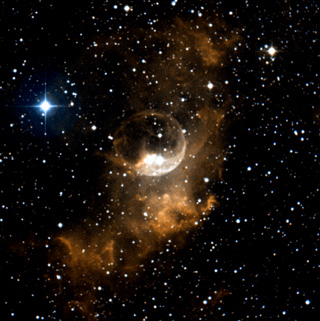Lying near the open
cluster M52, this faint nebula is a challenge for users of large and
small telescopes alike. Just glimpsing any of it in six inch or
smaller instruments is a bit of a feat, and larger telescopes
promise to reveal intricate details. Sky & Telescope described,
"a bright uniform disc 2' across surrounding a 9th magnitude
star," as seen in a six inch telescope.
For me, this one was
tough in my six inch, even from the dark skies of the Sacramento
Mountains of New Mexico. I've shaded in the area in the chart below
to match my observation, which represents the field as seen in my
scope at 50x. North is down and east is to the right. You may need
to adjust your monitor to see the shaded region.  Using
averted vision I was able to briefly glimpse a very faint hazy bar
between stars 1 and 2. I also had the impression of some haze to the
right of the bar. I made this observation not having read any
descriptions of the nebula. I failed to notice the bright disk
described above, which would surround my star 1, but I tend to
dismiss haze around bright stars as the result of humidity. I only
recently realized that I was seeing nebulosity around stars in the
Pleiades, for instance, but that's another story... Using
averted vision I was able to briefly glimpse a very faint hazy bar
between stars 1 and 2. I also had the impression of some haze to the
right of the bar. I made this observation not having read any
descriptions of the nebula. I failed to notice the bright disk
described above, which would surround my star 1, but I tend to
dismiss haze around bright stars as the result of humidity. I only
recently realized that I was seeing nebulosity around stars in the
Pleiades, for instance, but that's another story...
 The
image below was generated by combining red and blue second
generation DSS images. It shows the central area above (star 1 is
the bright blue star to the left, 2 is just off the image on the
bottom left). It is clear from the image that I saw the
surrounding nebulosity in the 6-inch rather than the Bubble itself. The
image below was generated by combining red and blue second
generation DSS images. It shows the central area above (star 1 is
the bright blue star to the left, 2 is just off the image on the
bottom left). It is clear from the image that I saw the
surrounding nebulosity in the 6-inch rather than the Bubble itself.
In larger instruments a
round glow can be seen about my star 1. At 150x or higher this glow
may appear asymmetrical, splitting into distinctly separate arcs.
 The
Bubble appears to be the consequence of the massive, hot 06.5III
star SAO 20575 (centered in the image above). Not only is this star
exciting the surrounding gas to glow via its prodigious UV
radiation, it apparently ejected a shell of gas and dust out into
those surrounding clouds some 300,000 years ago. Both the star
and the ejected material were initially moving rapidly through this
region. As the ejected material interacted with the nearby molecular
cloud it created the arcs of the bubble--a dusty blister on the edge
of a molecular cloud. In the process it was also slowed. The
"central" star continued along, moving away from the
bubble center in the intervening years to where we see it now. The
Bubble appears to be the consequence of the massive, hot 06.5III
star SAO 20575 (centered in the image above). Not only is this star
exciting the surrounding gas to glow via its prodigious UV
radiation, it apparently ejected a shell of gas and dust out into
those surrounding clouds some 300,000 years ago. Both the star
and the ejected material were initially moving rapidly through this
region. As the ejected material interacted with the nearby molecular
cloud it created the arcs of the bubble--a dusty blister on the edge
of a molecular cloud. In the process it was also slowed. The
"central" star continued along, moving away from the
bubble center in the intervening years to where we see it now.
The Bubble bears a
remarkable similarity to Thor's
Helmet.
|